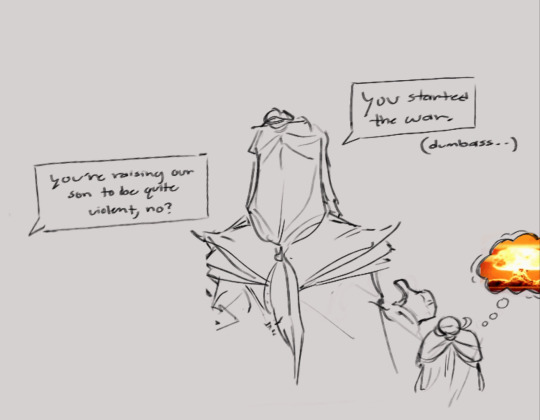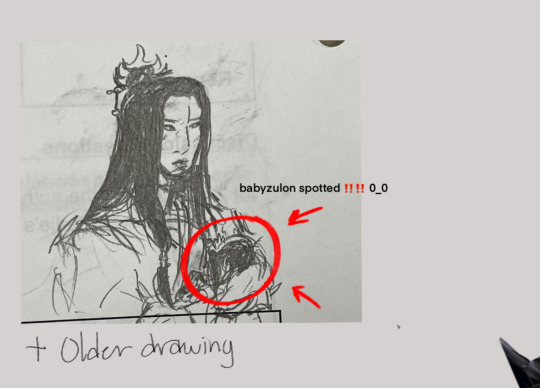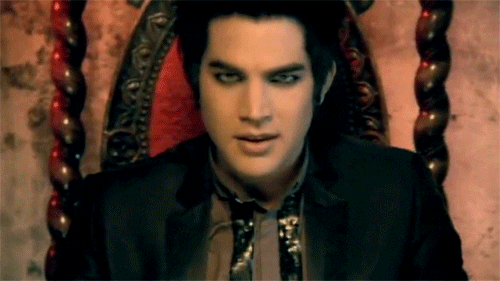#or predicting it. this is like mid 1700’s in real time
Text
Azulon’s mom design ‼️




love her so much. There’s like zero content of her

#azulon#Azulon’s mom#atla#she’s such an oc at this point it hurts#did sozin asexually reproduce or what bryke.#I find it hilarious how Azulon looks absolutely nothing like his father. get fucked idiot#three hip hip horays for women who are HORRIBLE !!!#the SWT hates her for what she did (make Azulon)#kid Azulon my little weirdo… fantasizing abt the atomic bomb#or predicting it. this is like mid 1700’s in real time#she’s very… fox like… to me
49 notes
·
View notes
Photo


Shax - Demon of Chaos - Original Fallen / Dani Filth - Solomon Julian Ignacio - Son of Chaos / Halfling / Adam Lambert
Double bio
Shax / Demon of Chaos - Original Fallen Angel / Jules’ Father
The Lesser Key of Solomon attempts to describe him. Man only knows so much. He’ll tell none his story. But Julian knows it all too well and how it affects all their lives.
From the Lesser Key
“(44.) SHAN. - The Forty-fourth Spirit is Shax,
or Shaz (or Shass). He is a Great Marquis and
appeareth in the Form of a Stock-Dove, speaking
with a voice hoarse, but yet subtle. His Office is to
take away the Sight, Hearing, or Understanding of
any Man or Woman at the command of the
Exorcist; and to steal money out of the houses of
Kings, and to carry it again in 1,200 years. If
commanded he will fetch Horses at the request of
the Exorcist, or any other thing. But he must first
be commanded into a Triangle, Ò, or else he will
deceive him, and tell him many Lies. He can
discover all things that are Hidden, and not kept
by Wicked Spirits. He giveth good Familiars,
sometimes. He governeth 30 Legions of Spirits,
and his Seal is this, etc.”
Another interpretation:
“Marquis Shax
Shax[4] (also spelled Chax, Shan, Shass, Shaz, and Scox) is a Great Marquis of Hell, and has power over thirty legions of demons. He takes away the sight, hearing and understanding of any person under the conjurer’s request, and steals money out of kings’ houses, carrying it back in 1200 years. He also steals horses and everything the conjurer asks. Shax can also discover hidden things if they are not kept by evil spirits, and sometimes gives good familiars, but sometimes those familiars deceive the conjurer.
Shax is thought to be faithful and obedient, but is a great liar and will deceive the conjurer unless obliged to enter a magic triangle drawn on the floor. He will then speak marvellously and tell the truth.
He is depicted as a stork that speaks with a hoarse but subtle voice; his voice changes into a beautiful one once he entered the magic triangle.”
Interpretations don’t mean much to Jules. The last thing Shax can be is summed up in a few short sentences. He embodies chaos; feeds from it; great powerful, dizzying and destructive to any life he touches.
Zodiac Position: 5-9 degrees of Scorpio - October 28th-November 1st
Tarot Card: 5 of Cups
Planet: Mars/Pluto
Candle Color: Black
Plant: Purslane
Metal: Iron/Plutonium
Element: Water
Rank: Marquis
Control Over: 30 Legions
Demon of: Chaos
Half Demon | Original Character | Adam Lambert
PERSONALITY & DEMEANOR
"I have walked a million miles in a hundred pairs of shoes
In search of some universal truth
Well a deity just came to me and handed me a scroll to read
And I will gladly pass it on to you”
Jules is a highly animated person. He’s predictably unpredictable. When getting acquainted with Jules one finds out pretty quickly that you just can never really know what’s going to come out of his mouth except for the fact that whatever it is, is going to be outrageous. He’s highly impulsive and will jump up and be rearing to go at the first thought of any idea ready to take action. He’s an “everybody’s friend” type of personality and a real go-getter. Stagnancy and boredom are things he just refuses to take part in and has to be doing something all the time.
He can be cynical, sarcastic, or dirty-minded to the rude degree. He has a temper that can tantrum out in the most child-like ways. But, he’s also a bit of a comic, witty, with an air of truth to his humor. He can be quite the pranking mischievous creature and is often up to something..
Jules also has a drastically softer side that only his nearest and dearest would ever really get to see when all the public flamboyance falls away behind closed doors. It’s a side that isn’t just good, or nice, or sweet, or cute, but it’s fragile and Jules is easier to break than all his confident air would allow people to assume.
FULL NAME
: Solomon Julian Charbonneau
NICKNAMES
: Jules
SPECIES
: Half-Angel
(born of a fallen angel/demon father [The Great Marquis Shax, Demon of Chaos] and a human mother)
CURRENT AGE
: Somewhere around 500 years old (His demonic father withheld his true birth date)
DATE OF BIRTH
: Unknown
PLACE OF BIRTH
: Unknown
PLACE RAISED AS A CHILD
: Hell
PERSONAL HISTORY
“I’ve gotten drunk and shot the breeze with kings of far off lands
They showed me wealth as far as I could see.
But their kingdoms seemed all shrivelly
and they all cried with jealousy
When I leaned in and told them about you.”
As the son of the Demon of Chaos, Jules’ life has always been full of it. As a half demon himself, He would thrive in it and created it in his every footstep, but not always purposely. It follows him and has a way of always consuming his life.
His life is often preoccupied by beauty, outer and his own. Even his parents coming together was based on it. His father, Shax would come in the form of a mutated gargoyle-esque stork. He passed those feathers on to Jules in his demon form as a Gryffin
His mother was a human who consented to a contract with the Demon Marquis Shax. The contract gave her the beauty she coveted in exchange for her soul. Shortly after, Shax coveted the beauty he created, henceforth Julian was born. What his mother didn’t realize was that she wasn’t to enjoy her beauty for long. Immediately becoming pregnant, gaining weight, spoiling her new found body, becoming bedridden, only to die in childbirth, Julian never knew her. He killed her. His powers gone amuck with his departure from the womb.
Jules was raised in Hell as a demon and his greatest desires included boasting his accomplishments of power and souls gained for Hell’s purpose, completely fearing retribution for not living up to his father’s legacy. Shax commanded thirty legions. Jules never did command any.
Jules history as a half-demon is a long and well-traveled one dating back to the 1500’s playing games with Pirates in the Second Anglo-Dutch War. But, much of his time was spent traipsing European countries, spending much time in Italy. Venice remains his favored place. This is where he learned more of romance tapping into his more human emotions. After the abolishment of the Italian monarchy and republic establishment he moved along. He spent the mid 1700’s in France robbing the royalty of Louis XV, he also made “friends” with chief mistress (Maîtresse-en-titre) Madame de Pompadour. He played a part in fashioning the Pompadour hairstyle and high-heels. But, it was his time spent in Germany where Jules created his largest scale demonic feat in the Holocaust era boosting German pride causing much of the tragedy that was WWII between 1939 - 1945. He stayed in the area until Mussolini was shot in 1945. It was soon after the part he played there, with his largest scale demonic crime, that it took it’s toll on his conscious (building his heart’s wall) and his life started to turn away from creating harm to human-kind and focused even more towards self-indulgence. This was when he moved to the United States and started forging a path that stayed only in the limelight of the stage through cabarets and vaudeville acts until modern day nightclubs became more his home.
Through his struggles and continual set-backs trying to rise up the demon social ladder and hierarchy, there was a time he considered his mother to be the reason for all his struggles, being tainted by human blood. But, the harbored guilt for harming a race he was also a part of was finally released bringing him to his knees in the arms of a do-gooding vigilante vampire. He soon saw himself tainted by the demon blood that cursed his life, beginning a newer struggle for being “good” while his demonic animal-like instincts still reigned strong over his willpower and desire to help the innocent.
FACTS & TID BITS
“I know I’ll stumble
I know I’ll still face defeat
These second chances will define me
So I’m moving forward
I’m standing on my two feet
I’ve got momentum
I’ve got someone saving me”
POWERS
As a direct descendent of Shax, the Great Marquis of Hell, Demon of Chaos, he was passed many but not all of his father’s qualities such as taking away the sight, hearing, and understanding of people, steals money and horses, can also discover hidden things if they are not kept by evil spirits, and creates and calls forth familiars (giving him a connection to the animal kingdom, providing totems to others), but sometimes those familiars deceived the conjurer. He exceled in lying and betrayal. He was also born with a few powers unique to himself such as the ability to invoke three feelings…envy, pride, and fear, and fed from them, for sustenance. Plus, he could produce tangible illusions/hallucinations. He can gauge the strength of people’s souls, a useful skill in sizing up a potential victim for recruitment to Hell, and identifying species.
WEAKNESSESS
If he is confined to a triangle, he will speak truth on supernatural matters, point out hidden treasures not guarded by evil spirits, and obey the exorcist. He gets weak if he doesn’t get his emotional “feeds”. He also harbors hindering guilt over what he puts people through to get those feeds. Unstable emotions and the scent/sight of blood can bring out his demon form.
PLAY BY
: Adam Lambert
Theme Songs
For Demon-Kind
The End
For Self
What I’ve Overcome
Some of Jules’ Job History
: He once worked in Bodfish partime to work at the
Silver City Ghost Town
. He uses his powers to play with the tourists making them think they see more than is really there. He only worked weekends.
He was also into “Alternative Modeling” and has an agent through the HVQ Agency
He was in management training at
The Abbey
(Best Gay Bar in the World as Voted by LOGO TV) and mingling with big wigs with the
SBE.
He has also been a member of the
The Celebration Theater
a professional LGBT acting group. He has a tendency to take understudy roles and helps with costumes, hair, make-up, and stage-tech duties.
Messenger Boy
Black Jack Dealer
Ghost Hunter Tour guide. (used power to invoke fear and illusions he had a great time making the tours far more interesting)
Full Time Drag Queen
Club Owner/Businessman: 3 story entertainment complex called The Rabbit Hole
Been a part of Auto Theft Rings, and Larceny Rings as well.
Traveling Minstrel
Cabaret Dancer
Vaudevillian Singer
Magician
Japanese Senti Attendant
(Though most regular human-type jobs he’s taken on are just play money. As a demon the most of his finances came from Larceny. Jules considered himself the King of Thieves) often working with curators of museums as a treasure hunter hobbiest selling stolen antiquities and creating fakes. He only works jobs to infiltrate human kind. He’s not doing it for money or to contribute to society)
More Facts
~ Loves 18th century European art.
~ As a demon was in charge of caring for the demon horse mares in Hell
~ Loves show tunes and musicals
~ Adores Classical Music
~ Is an Antique Roadshow junkie
~ Is a whizz with a Bedazzler
~ Has taken ballroom dancing lessons
~ Has taken Tae Kwon Do and weapons classes in Thailand (not advanced in these skills but he likes to pretend to be)
~ Loves to Sing
~ Designs & tailors his own fashions (was once employed as the devil’s tailor)
~ Keeps up with designer labels
~ Avid club goer
~ Likes to be treated like a “Princess"
~ Much of his antique and art collection was stolen from European royalty with his Father centuries ago. But has since burned almost everything that had to do with his demonic days setting the past free of him.
~ Wrap Sheet. (Grand Theft Auto {was caught on purpose as a distraction for a bigger heist, sentenced to probation}, Grand Larceny of the 1st degree {Class B Felony, sentenced to 12 years, but only served one month thinking it might be fun to hassle the prisoners, then got bored, and used his powers to convince a judge to give him a get out of jail free card}, Petit Theft {got caught on purpose as a distraction for others, never served time.} Jules has had numerous DUI’s, speeding tickets, and public nudity charges.
Even More Facts
Likes
: Attention, sincerity, new experiences
Dislikes
:Boredom, stagnancy, dull colors,
Fears
: Satan, his father Shax, and other demons
Education
: Educated in Hell in demonic ways, hasn’t completed any true degrees on Earth, but has often posed as students from elementary age to university with his power of illusion to learn things or get things he wants to experience at that moment in time.
Season:
Fall
Color:
Purple
Food:
Comfort Foods, and pasta
Ice Cream:
Dark Chocolate
Smell:
Lavender
Drink:
Frappes'
Hobbies:
Building bird houses & doll houses,
Instruments:
Lute, Piano, Voice
Music:
eclectic tastes through the ages, often sticking with what’s modern at the time, staying current
Fav Songs:
Simply Red's
A Song For You
Matt Alber's
End of the World
Movies:
Les Miserables, Rent, Up, Anything Disney or Tim Burton
Book:
Illusions: The Adventures of a Reluctant Messiah, by Richard Bach
Tatts/Piercings:
He has a My Little Pony tattoo on his hip, some lines from the Song of Solomon on his ribs, The Eye of Horus on his wrist along with an infinity sign, He has piercings only lover’s tend to find (yes that’s what you think it means). He once had a cross on his back between his shoulder blades. This was his first line of defense to warn him if he started to sin. It would burn him if he crosses too far over the line. He’s since cut it off of himself.
1 note
·
View note
Text

The Truth About Marijuana... Marijuana is many things to many people. This should not be surprising since the relationship between mankind and this herbaceous plant extends back to literally the dawn of civilization. However, most people are surprised to learn that marijuana is not the ominous threat they’ve been led to believe through drug war propaganda. Then why is it portrayed so negatively by the U.S. Drug Enforcement Administration and others? Good question! The time has come for an understanding based on education – to rise above the ignorance. So let’s examine the historical context behind marijuana prohibition and learn some facts about the plant known as marijuana… The name “marijuana” is a Mexican slang word. The actual Spanish word for the plant is “canamo.” Prior to the mid-1930’s, marijuana was known throughout the world as “hemp” or “cannabis.” Cannabis is the plant’s botanical name and has ancient origins in the Hebrew language. Solid evidence of Hebrew cannabis usage was established in 1936 by Mr. Sula Benet, an etymologist from the Institute of Anthropological Sciences in Warsaw. The word “cannabis” was generally thought to be of Scythian origin, but Mr. Benet showed that it has a much earlier origin in Semitic languages like Hebrew, and that it actually appears several times throughout the Old Testament. Mr. Benet explained that “in the original Hebrew text of the Old Testament there are references to hemp, both as incense, which was an integral part of religious celebration, and as an intoxicant.” As one of the ingredients for the anointing oil, it would have been used to anoint Abraham, all the priests, and even Jesus. Mr. Benet demonstrated that the word for cannabis is “kaneh-bosm,” also rendered in traditional Hebrew as “kaneh” or “kannabus.” The root “kan” in this construction means “reed” or “hemp”, while “bosm” means “aromatic.” This word appears five times in the Old Testament; in Exodus 30:22-30, Song of Songs 4:8-14, Isaiah 43:23-24, Jeremiah 6:20 and Ezekiel 27:19. The word kaneh-bosm is sometimes mistranslated as calamus, a common marsh plant with little monetary value that does not have the qualities or value ascribed to kaneh-bosm. In many Bible translations, it is simply called “fragrant cane” or “sweet cane.” Here are some more historical facts about hemp (with references), which are generally verifiable in the Encyclopedia Britannica – which was printed on hemp paper for 150 years: The oldest known records of hemp farming go back 5000 years in China, although hemp industrialization likely extends back to ancient Egypt. Medical cannabis was described in print in a Chinese book of medicine, “Herbal,” in the 2nd century B.C. The first Bibles, maps, charts, Betsy Ross's flag, the first drafts of the Declaration of Independence and the Constitution were made from hemp; U.S. Government Archives. Founding fathers George Washington, Thomas Jefferson and others grew hemp. Jefferson smuggled hemp seeds from China to France and then to America; Washington and Jefferson Diaries. It was legal to pay taxes with hemp in America from 1631 until the early 1800’s; LA Times, Aug. 12, 1981. In fact, refusing to grow hemp in America during the 17th and
18th Centuries was against the law! You could be jailed in Virginia for refusing to grow hemp from 1763 to 1769; G. M. Herdon, Hemp in Colonial Virginia. The first crop grown in many states was hemp. HEMPstead, Long Island; HEMPstead County, Arkansas; HEMPstead, Texas; HEMPhill, North Carolina; HEMPfield, Pennsylvania, among others, were named after cannabis growing regions, or after family names derived from growing hemp; State Archives In 1916, the U.S. Government predicted that by the 1940’s all paper would come from hemp and that no more trees would need to be cut down since one acre of hemp equals four and a half acres of trees; U.S. Department of Agriculture. An article entitled 'The Most Profitable and Desirable Crop that Can be Grown' stated that if hemp was cultivated using 20th Century technology, it would be the single largest agricultural crop in the U.S. and the world; Feb, 1938, Mechanical Engineering Magazine. Paints and varnishes were made from hemp seed oil until 1937. America used 58,000 tons of hemp seeds for paint products in 1935; Sherman Williams Paint Company testimony before Congress against the 1937 Marijuana Tax Act, which outlawed hemp in the U.S. Henry Ford built a car to run on hemp gasoline and the car itself was constructed of plastic made with hemp. On his large estate, Ford was photographed among his hemp fields. The car, “grown from the soil,” had hempen plastic panels whose impact strength was “10 times stronger than steel” and resisted denting though it was one-third lighter than steel; Dec 1941, Popular Mechanics. The following quote is from the U.S. Department of Agriculture's film titled ‘Hemp for Victory.’ The U.S. government denied it and tried to hide its existence for years, since it encouraged patriotic American farmers in 1942 to grow hemp for the war effort. Now “re-discovered”, it can even be watched on YouTube: “... (When) Grecian temples were new; hemp was already old in the service of mankind. For thousands of years, this plant had been grown for cordage and cloth in China and elsewhere in the East. For centuries prior to about 1850, all the ships that sailed the western seas were rigged with hempen rope and sails… Now with Philippine and East Indian sources of hemp in the hands of the Japanese... American hemp must meet the needs of our Army and Navy as well as of our industries… the Navy's rapidly dwindling reserves. When that is gone, American hemp will go on duty again… hemp for countless naval uses both on ship and shore. Just as in the days when Old Ironsides sailed the seas victorious with her hempen shrouds and hempen sails. Hemp for victory!” Hemp cultivation and production actually benefit the environment. USDA Bulletin #404 concluded that hemp produces 4 times as much pulp with at least 4 to 7 times less pollution. From Popular Mechanics, Feb. 1938: “It has a short growing season… it can be grown in any state… The long roots penetrate
and break the soil to leave it in perfect condition for the next year's crop. The dense shock of leaves, 8 to 12 feet above the ground, chokes out weeds... hemp, this new crop can add immeasurably to American agriculture and industry.” With so many positive historical examples of cannabis usage, what disrupted the course of history and caused the interwoven relationship of Americans and the hemp plant to unravel? AMERICAN MARIJUANA HISTORY One of America’s founding principles is the protection of individual rights… probably the most basic of which is the right to nature and to your own body. So why is a plant that is used by millions of people a major target for law enforcement? Conspiracy theories abound regarding various groups who profited from cannabis prohibition in 1937, such as the Hearst-controlled paper industry that did not want competition from hemp. While that is very likely a factor, the real driving force behind cannabis prohibition then and now is that anti-marijuana laws provide a political tool to persecute millions of people defined by race as well as cultural and political affiliation. Cannabis was grown commercially in the U.S. since the 1700’s. However, recreational cannabis usage was not a strong cultural factor until much later with the arrival of Africans and Hispanics. Marijuana prohibition provided racial activists the perfect opportunity to persecute those “undesirable” minorities. Furthermore, the repeal of alcohol prohibition threatened the employment of thousands of prohibitionists and law enforcement personnel. Cannabis prohibition provided these large and powerful groups with ongoing job security and helped fund new prisons. But the concept of using marijuana laws against minorities was not original to U.S. lawmakers. The same tactic had already proven effective in many other countries. Twentieth-century cannabis prohibition first reared its ugly head in South Africa, where white minorities ruled black majorities and sought more control by outlawing “dagga” in 1911. The British outlawed “ganja” in Jamaica in 1913 to exert more influence over that colony. Canada's pot law was enacted in 1923 from the efforts of Emily F. Murphy – a blatantly racist judge who wrote anti-marijuana rants under the pseudonym “Janey Canuck.” Similar laws followed in Great Britain and New Zealand. In each instance, these laws were not based on any medical or scientific facts, but lawmaker’s prejudices against the racial groups that marijuana laws helped persecute and control. Marijuana prohibition in the U.S. began partly as an add-on to laws restricting opiates and cocaine to prescription-only usage, especially in Southern and Western regions where blacks and Mexican immigrants were using it. The LA Times claimed in 1914 that “sinister legends of murder, suicide and disaster” surround the plant. The city of El Paso outlawed marijuana in 1915, two years after a Mexican thug, “allegedly crazed by habitual marijuana use,” killed a police officer. By the time alcohol prohibition was repealed in 1933, thirty states had some form of marijuana law. The campaign against marijuana intensified after the repeal of alcohol prohibition. “I wish I could show you what a small marihuana cigarette can do to one of our degenerate Spanish-speaking residents,” a Colorado newspaper editor wrote in 1936. “The fatal marihuana cigarette must be recognized as a deadly drug, and American children must be protected against it.”
In a country willing to outlaw alcohol, enacting anti-marijuana laws was an easy political move. Both marijuana and alcohol prohibition were part puritanical fanaticism, part racist and part anti-immigrant. Bishop James Cannon of the Anti-Saloon League in 1928 denounced Italians, Poles and Russian Jews as “the kind of dirty people that you find today on the sidewalks of New York,” while in 1923, Imogen Oakley of the General Federation of Women's Clubs described the Irish, Germans, and others as “insoluble lumps of unassimilated and unassimilable peoples… 'wet' by heredity and habit.” In the South, the motivation was anti-black. Georgia prohibitionist A.J. McKelway wrote in 1907, “The disenfranchisement of Negroes is the heart of the movement in Georgia and throughout the South for the Prohibition of the liquor traffic.” Alcohol had been the most pervasive recreational drug in the Western world for millennia. This gave prohibitionists plenty of ammo to demonize “whiskey-sodden Micks, wine-soaked Wops, beer-swilling Krauts and liquor-selling Jews.” But at least those groups were not dark-skinned like the Mexicans and African-Americans who were the primary users of cannabis at that time. Instead of calling it hemp or cannabis, an obscure Mexican slang word: “marihuana”, was pushed into the American consciousness along with racial denunciations in headline stories that shocked the nation. Films like 'Marihuana: Assassin of Youth' (1935), 'Marihuana: The Devil's Weed' (1936) and 'Reefer Madness' (1936), financed by a church group, promoted the message of “the new drug menace… destroying the youth of America in alarmingly increasing numbers.” Reefer Madness is now viewed as an unintentional comedy by modern audiences, and it even premiered as an off-Broadway musical satire in 2001. However, people in the 1930’s were naive to the point of ignorance, and did not often challenge or question authority. The masses were like sheep, waiting to be led by the few in power. If the news was in print or other media, most believed it had to be true… especially the unfamiliar and frightening topic of marijuana. Unfortunately, that still applies to many people today. The charge against marijuana was led by Harry Anslinger, head of the Federal Bureau of Narcotics, and previously the Federal Assistant Alcohol Prohibition Commissioner. “If the hideous monster Frankenstein came face to face with the monster marihuana, he would drop dead of fright,” Harry thundered in 1937. His racial claim was that white girls would be ruined once they'd experienced the lurid pleasures of having a black man's marijuana joint in their mouths. “Colored students at the University of Minnesota partying with female (white) students smoking and getting their sympathy with stories of racial persecution, result: pregnancy.” In 1937, The Prohibitive Marihuana Tax Law (the bill that outlawed cannabis) was brought before the House Ways and Means Committee before enough information was available to counter its deceitful claims. American Medical Association representative Dr. James Woodward testified before the committee that the AMA had not denounced the law sooner because they had just discovered that “marihuana” was actually cannabis – the medicine found in numerous healing products of that century. Very few people realized that the “deadly menace” they had been reading about on the front pages was actually cannabis. So when Congress passed the Marihuana Tax Act, this tremendous natural resource was suddenly illegal. Congress only agreed to prohibit cannabis because of a prejudiced lie. Anslinger convinced them that 50% of all violent crimes in the U.S. were committed by Spaniards, Mexican-Americans, Latin-
Americans, Filipinos, African-Americans and Greeks… and these crimes could be traced directly to marijuana. “I believe in some cases one cigarette might develop a homicidal mania,” he testified in a hearing on the bill, also stating that “marijuana is the most violence-causing drug in the history of mankind.” Later in the 1950’s, under the “McCarthyism” threat of Communism, Anslinger claimed the exact opposite to incite fear – stating that marijuana will pacify soldiers so much they will not want to fight. Neither position represents the truth. An Associated Press report on June 22, 1971 illustrates how cannabis inhibits neither bravery nor compassion: A Congressional Medal of Honor winner says he was “stoned” on cannabis the night he fought off two waves of Vietcong soldiers and won America's highest military honor... It was April 1, 1970, when Mr. [Peter] Lemon, an Army Specialist 4, used his rifle, machine gun and hand grenades to smash a large attack on his position. He fought the enemy single-handed and dragged a wounded comrade to the rear before collapsing from exhaustion and three wounds. At a medical center, he refused treatment until more seriously injured men had been cared for. The dispatch quoted the injured hero as explaining: “It was the only time I ever went into combat stoned. You get really alert when you're stoned...” When the youth counterculture emerged in the 1960s, its embrace of drugs forced lawmakers to deal with a sudden demographic change: marijuana was no longer confined to Hispanics and blacks. The sons and daughters of the white middle class were also “toking-up” in significant and increasing numbers. Many of the young “hippies” also embraced the Hindu religion and customs. Cannabis has been used as part of religious celebrations in India for several millenniums and still is today. But the Nixon-era escalation of the war on drugs used marijuana as a legal pretext to attack the '60s counterculture and ethnic groups. Richard Nixon's White House tapes captured him in 1971 growling that “every one of the bastards that are out for legalizing marijuana is Jewish.” The most successful propaganda of President Nixon (who founded the DEA) and other fanatical politicians, was lumping youthful cultural-political rebellion with black militance and ghetto heroin addiction. Cannabis prohibition is a remnant of that dark political era of our nation’s history and even today continues to be used to persecute various groups of all races to further cultural and political agendas. As recently as July 2010, the U.S. government used the “drug war” as a political excuse to station 46 warships and over 7,000 troops in Costa Rica – an incredible amount of firepower over some grass.
0 notes